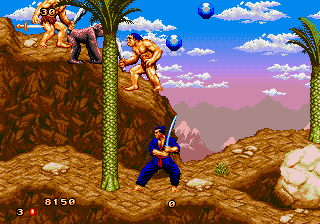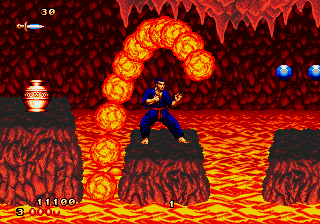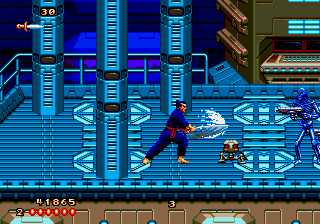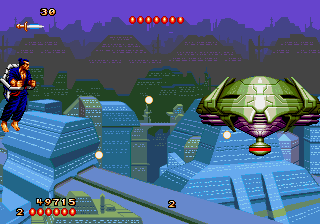The Second Samurai
From Sega Retro
| The Second Samurai | |||||||||||||||||||||||||
|---|---|---|---|---|---|---|---|---|---|---|---|---|---|---|---|---|---|---|---|---|---|---|---|---|---|
| System(s): Sega Mega Drive | |||||||||||||||||||||||||
| Publisher: Psygnosis, Sony Electronic Publishing | |||||||||||||||||||||||||
| Developer: Vivid Image, Psygnosis | |||||||||||||||||||||||||
| Supporting companies: Krisalis Software (audio) | |||||||||||||||||||||||||
| Distributor: Ecofilmes (PT) | |||||||||||||||||||||||||
| Sound driver: Krisalis sound driver | |||||||||||||||||||||||||
| Genre: Action | |||||||||||||||||||||||||
| Number of players: 1-2 | |||||||||||||||||||||||||
| |||||||||||||||||||||||||
|
The Second Samurai is a beat-'em-up developed by Vivid Image and Psygnosis and released exclusively in Europe for the Commodore Amiga in 1993 and for the Sega Mega Drive 1994. It is the sequel to The First Samurai, a beat-'em-up released for various home computers and the Super NES internationally a few years prior.
A Sega Mega-CD port was advertised and was planned to launch alongside the Mega Drive version[1][2], but never released.
Contents
Story
Two samurai pursue the Demon King through time.
Gameplay
The game is a side-scrolling beat-'em-up that can be played with one or two players. The first player plays as a male samurai, and the second player plays as a female samurai. Two-player games must be started from the title screen; a second player cannot join in the middle of a one-player game. In two-player games, the two samurai are occasionally placed in separate layers, with the male samurai in front and the female samurai in back (though this can be changed around in the game options). The goal of most stages is to free all of the souls trapped in jars, which grants access to the next segment of the stage and eventually to a boss fight. A counter in the bottom-center of the screen shows how many more souls must be freed. Some stages consist of a main path with entry points into shorter sub-stages (indicated by arrows) where more souls can be found. The game has significant platforming elements compared to arcade-style beat-'em-ups.
The samurai walk with ![]() and
and ![]() and crouch with
and crouch with ![]() . They jump with
. They jump with ![]() and jump down from platforms with
and jump down from platforms with ![]() +
+![]() . They attack by punching with
. They attack by punching with ![]() . They do a crouching punch with
. They do a crouching punch with ![]() +
+![]() or a crouching kick with
or a crouching kick with ![]() +
+![]() or
or ![]() +
+![]() . The crouching kick has longer reach and can hit some enemies that are too low for the crouching punch. They can uppercut to attack enemies above them with
. The crouching kick has longer reach and can hit some enemies that are too low for the crouching punch. They can uppercut to attack enemies above them with ![]() +
+![]() . They do a high kick with
. They do a high kick with ![]() +
+![]() or
or ![]() +
+![]() and a flying kick with
and a flying kick with ![]() while in midair. They can pick up opponents and some objects by holding
while in midair. They can pick up opponents and some objects by holding ![]() when in close proximity and throw them by releasing
when in close proximity and throw them by releasing ![]() while holding a direction on the D-Pad. While initially unarmed, they can pick up white scrolls, which give them samurai swords and replace their moves with an array of sword slashes. The sword does more damage and defeats enemies in fewer hits. The first standing attack after acquiring a white scroll hurls a fireball across the screen that penetrates through multiple targets. Samurai also obtain throwing knives, which are thrown with
while holding a direction on the D-Pad. While initially unarmed, they can pick up white scrolls, which give them samurai swords and replace their moves with an array of sword slashes. The sword does more damage and defeats enemies in fewer hits. The first standing attack after acquiring a white scroll hurls a fireball across the screen that penetrates through multiple targets. Samurai also obtain throwing knives, which are thrown with ![]() . They can be thrown while crouching with
. They can be thrown while crouching with ![]() +
+![]() or directly upward with
or directly upward with ![]() +
+![]() .
.
Health is depicted by six red balls in the bottom corners of the screen. The samurai lose a bit of health when they take damage from opponents. If a samurai falls down a bottomless pit, they jump back out after losing some health (rather than dying). Losing an entire health ball causes a samurai to lose his or her sword, if equipped. Losing all health balls costs the samurai his or her life. The samurai respawns at the last checkpoint (or the beginning of the stage) if the player has lives remaining, or the game ends if the player runs out of lives. In two-player games, both samurai respawn if one samurai is defeated (though only the player who ran out of health loses a life).
Players can select the number of starting lives (3, 5, or 7) and the difficulty level (Easy, Brave, Heroic, and "Samurai!") in the options before starting the game. There is a password system for continuing.
Items
| Gem | |
|---|---|
| Touch to release an item. | |
| Throwing Knife | |
| Gives the samurai another throwing knife, up to a maximum of 30. | |
| Extra Energy | |
| Restores half a ball of the samurai's health. | |
| Full Energy | |
| Restores all six balls of the samurai's health. | |
| White Scroll | |
| Arms the samurai with a sword and makes their next attack shoot a fireball. Collecting multiple scrolls gives the samurai multiple fireballs. | |
| Yellow Scroll | |
| Leaves the current sub-stage. | |
| Red Scroll | |
| Destroys all enemies on screen. | |
| Blue Scroll | |
| Renders the samurai temporarily invulnerable. | |
| Blue Vase | |
| Attack to release the soul trapped inside. The samurai must release all of the souls to progress through the stage. | |
| Yellow Vase | |
| Checkpoint where the samurai respawn when defeated. Attack to activate. | |
| Barrier | |
| Bars the way. The samurai can pass if they free all the souls in the preceding part of the stage. |
Stages
History
Legacy
The Mega Drive version of the game was re-released on Steam in 2022 by Piko Interactive.
Versions
The Mega Drive version differs significantly from the Amiga original. It has different stage layouts, graphics, and music. The "second samurai" is a bald-headed monk in the Amiga version but a female warrior in the Mega Drive version.
Production credits
- Programming: Raffaele Cecco
- Graphics and Animation: Saurav Sarkar
- Audio: Krisalis Software
- Musical Composition & Sound Effects: Matt Furniss
- Audio Software Programming: Shaun Hollingworth
- Game Design: Raffaele Cecco, Mev Dinc, Saurav Sarker
- Map Layouts: Raffaele Cecco, Saurav Sarkar
- Development Tools: PsyQ by S.N. Systems/Psygnosis, Jaguar Software Consultants, Raffaele Cecco, Warren Mills, Rob Northern Computing
- Vivid Image Project Management: Stephane Koenig
- Psygnosis Project Management: Nick Wilde
- Vivid Image Game Tester: Stefan 'The Herb' Marjoram, Nejati Dinc
- Psygnosis Game Testers: Chris Graham, Paul Holmes, Paul Wallace
- Special Thanks to...: Bill Hajee, Chris West, Tony West, Harris Bernardez, John Twiddy, The Infamous PCW Disk Wallet
Magazine articles
- Main article: The Second Samurai/Magazine articles.
Promotional material
also published in:
- Velikiy Drakon (RU) #61: "xxxx xxxx" (2003-02-07)[4]
Physical scans
| Sega Retro Average | ||||||||||||||||||||||||||||||||||||||||||||||||||||||||||||||||||||||||||||||||||||||||||||||
|---|---|---|---|---|---|---|---|---|---|---|---|---|---|---|---|---|---|---|---|---|---|---|---|---|---|---|---|---|---|---|---|---|---|---|---|---|---|---|---|---|---|---|---|---|---|---|---|---|---|---|---|---|---|---|---|---|---|---|---|---|---|---|---|---|---|---|---|---|---|---|---|---|---|---|---|---|---|---|---|---|---|---|---|---|---|---|---|---|---|---|---|---|---|---|
|
| 69 | |
|---|---|
| Based on 18 reviews | |
| Mega Drive, AU |
|---|
|
Technical information
- Main article: The Second Samurai/Technical information.
References
- ↑ 1.0 1.1 1.2 Mega Power, "May 1994" (UK; 1994-04-21), page 7
- ↑ Sega Pro, "July 1994" (UK; 1994-06-16), page 10
- ↑ File:Second Samurai MD credits.pdf
- ↑ Velikiy Drakon, "xxxx xxxx" (RU; 2003-02-07), page 68
- ↑ GamesMaster, "December 1994" (UK; 1994-11-17), page 77
- ↑ 1700 igr dlya Sega, "" (RU; 2001-xx-xx), page 201
- ↑ Alaab Alcomputtar, "" (SA; 1995-08-xx), page 73
- ↑ Cool Gamer, "9" (RU; 2002-10-13), page 182
- ↑ Entsiklopediya luchshikh igr Sega. Vypusk 1, "" (RU; 1999-xx-xx), page 356
- ↑ Entsiklopediya luchshikh igr Sega. Vypusk 3, "" (RU; 2000-xx-xx), page 237
- ↑ MAN!AC, "12/94" (DE; 1994-11-09), page 82
- ↑ Mega Force, "Janvier 1995" (FR; 199x-xx-xx), page 54
- ↑ Mega Fun, "12/94" (DE; 1994-11-23), page 124
- ↑ Player One, "Janvier 1995" (FR; 199x-xx-xx), page 118
- ↑ Play Time, "12/94" (DE; 1994-11-09), page 109
- ↑ Sega Magazin, "Dezember 1994" (DE; 1994-11-17), page 69
- ↑ Sega Magazine, "December 1994" (UK; 1994-11-15), page 97
- ↑ Sega Power, "November 1994" (UK; 1994-09-29), page 55
- ↑ Sega Pro, "December 1994" (UK; 1994-11-03), page 42
- ↑ Sega Mega Drive Review, "2" (RU; 1996-01-03), page 123
- ↑ Todo Sega, "Enero 1995" (ES; 199x-xx-xx), page 55
- ↑ Tricks 16 bit, "Tricks Sega Gold 800 igr" (RU; 1998-03-20), page 153
- ↑ Video Games, "12/94" (DE; 1994-11-23), page 111
| The Second Samurai | |
|---|---|
|
Main page | Comparisons | Maps | Hidden content | Magazine articles | Video coverage | Reception | Region coding | Technical information | Bootlegs | |
- 1-2 player games
- EU Mega Drive games
- All EU games
- PT Mega Drive games
- All PT games
- UK Mega Drive games
- All UK games
- AU Mega Drive games
- All AU games
- Mega Drive games
- 1994 Mega Drive games
- All 1994 games
- Mega Drive action games
- All action games
- All games
- Old-style rating (consolesplus)
- Rating without source
- Old-style rating (gamesmaster)
- Old-style rating (joypad)
- Update ratings template
- 2 old ratings
- The Second Samurai
- Unreleased Mega-CD games









































